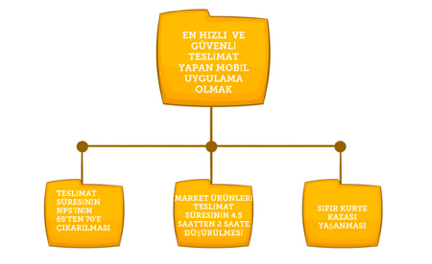What if STATIK and OKR Combine
In this article, I will share a concept that will combine OKR with another approach, which I hope will help teams build a system that fits their purpose: STATIK with OKR.
OKR is a term you've probably heard a lot recently. In this article, I will share a concept that will combine OKR with another approach, which I hope will help teams build a system that fits their purpose: STATIK with OKR. Unfortunately, I haven't come up with a more imaginative name for it yet, but I'll consider any suggestions :)
First of all, I want to start with “what is STATIK? and what is OKR?”.
STATIK (Systems Thinking Approach To Introducing Kanban) is an approach that enables you to analyze your purpose, needs, and current situation in the team you want to apply Kanban to, and to construct an appropriate system (board, meetings, metrics, graphics, WIP limits, rules, etc.). STATIK is an 8-step framework that is applied especially in teams that are just starting to work with Kanban and pulls them towards a more systemic way of thinking;
0. Understand what makes the business fit for your purpose
1. Understand the current sources of delivery dissatisfaction
2. Analyze the source and nature of your demands
3. Analyze your current delivery ability
4. Model your service delivery workflow
5. Identify and define service classes
6. Design the kanban system
7. Socialize the design and negotiate the implementation
You can perform these steps either in a single session or spread over several sessions. In any case, you will have designed a system that is suitable entirely for your purpose. Although Kanban University claims that STATIK is an approach that should be repeated and improved upon over time, I have my doubts about how well the teams adhere to it in practice :)
At this point, OKR enters our lives.OKR is actually a goal-setting protocol, a kind of framework, consisting of the English initials of Objectives and Key Results. We set OKRs in 2 stages: first our goals, then our key results. Goals can be briefly defined as simple and understandable sentences that guide and inspire us. For example, "To be Turkey's fastest and most reliable delivery mobile application" may be: We generally prefer the number of target sentences to be at least 3 and at most 5. However, in the STATIK with OKR approach, we will set only 1 target sentence for ourselves. We use key results to answer the questions “Am I really moving towards this goal we set? Did I shift my ground? How will I know if I'm making progress?”. Key results are measurable, clear sentences that leave no room for gray areas and of which answer is “yes” or “no” when it is asked “Did we do that?”, and we set at least 3 and at most 5 key results per goal (just like in target sentences). For example, the key results of the sentence “To be Turkey's fastest and most reliable delivery mobile application” may be:
- Increase NPS of delivery time from 65 to 70
- Reducing the average delivery time in Istanbul from 4.5 hours to 2 hours in the grocery products category
- Zero courier accident
So, at this point, our OKR is;

Since we review and renew OKRs on a quarterly basis, it puts pressure on us to reach these goals within a limited time, and inevitably takes us out of our comfort zone.
So why should we feel the need to use these two separate concepts together? This was, in fact, a question raised at a recent workshop. Later, while talking to our dear friends Ahmet Özcan and Murat Yurdakul, when they came up with this idea, we said: "let's give it a try" and to our opinion the result was perfect :)
We actually had a few needs, both on the STATIK and OKR sides. Because we do not specify a time limit when using STATIK, we may confront circumstances where teams frequently continue to use the same system, where our goal-setting without understanding the root cause causes us to not internalize our purpose, where we are lost among many metrics that do not serve our purpose when we try to keep metrics, and where we sometimes ignore innovation or development areas because it is a system-oriented approach, etc. If there is no system in place where we wish to adopt OKR, it may take time for the balances to settle, and our confidence in our ability to achieve those exciting goals may be shaken. This is exactly why we believed that combining the two would be a great idea.
When we combine the 0th and 6th steps in the STATIK steps I outlined above with OKR and combine them with the time constraint that OKR (generally) determines as a quarter, I believe STATIK will evolve into a far more effective form.
Set your OKRs as you try to find your purpose in step 0. Discover your own purpose by utilizing the most important, inclusive, and primary goal here.
In the 6th step, while setting the details of the Kanban system you are trying to build (our board's design details, our meetings, our rules, our WIP limits, our metrics, etc.), get support from the key results you set in the 0th step. That is if our key result is 'Making NPS of delivery time greater than 70', bring your system into a format that will fully serve your purpose, with questions such as “What metrics should we keep to achieve this?, How often and what meetings/feedback loops should we set up?”.
So in summary, with STATIK with OKR;
0. Find your purpose/target by going through root causes (OKR determination)
1. Understand the current sources of delivery dissatisfaction
2. Analyze the source and nature of your demands3. Analyze your current delivery ability
4. Model your service delivery workflow
5. Identify and define service classes
6. Design the Kanban system and benefit from your key results when designing it.
7. Socialize the design and negotiate the implementation
P.S. : Special thanks to Ahmet Özcan and Murat Yurdakul for the idea :)




Comment(s)